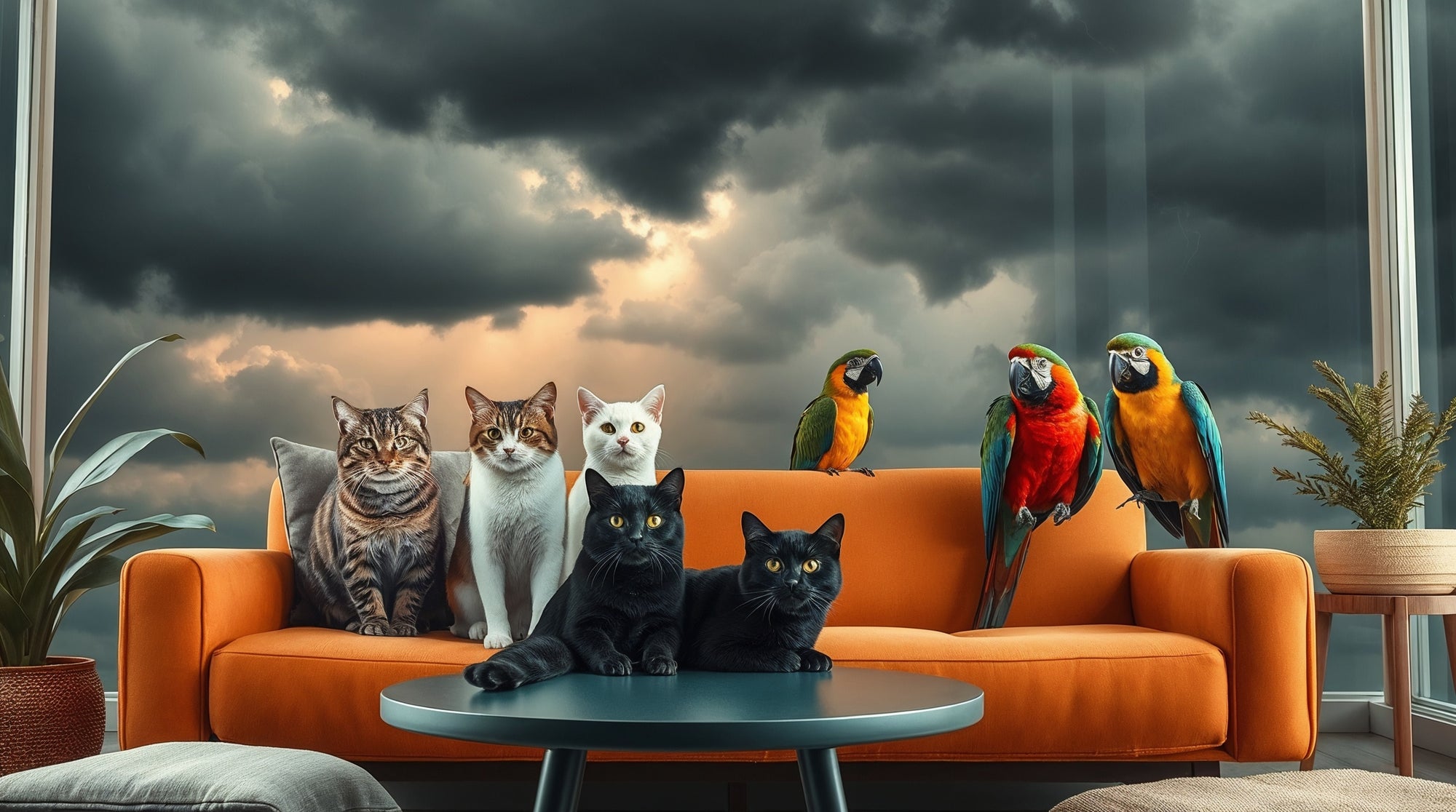Let's start with a shocking statistic: 60% of cats in developed countries are overweight or obese, according to the Association for Pet Obesity Prevention. Even more alarming? Most cat parents have no idea their feline is fat because we've normalized chubby cats as "cute" rather than concerning.
But weight is just the tip of the iceberg. From feeding frequency to water consumption, from protein requirements to the great wet-versus-dry-food debate, most of us are making well-intentioned mistakes that could be shortening our cats' lives by years.
The truth is, our domestic cats are only about 4,000 years removed from their African wildcat ancestors—practically yesterday in evolutionary terms. Their digestive systems are virtually identical to their desert-dwelling predecessors who hunted small prey and rarely encountered carbohydrates. Yet we feed them like small dogs, wonder why they develop diabetes at alarming rates, and accept "senior cat" health issues as inevitable.
They're not. Let's dive into what science actually tells us about feline nutrition and how to help your cat live not just longer, but better.
The Carnivore Conundrum: Why Your Cat Is Not a Small Dog
Obligate Carnivore: More Than Just a Preference
Unlike dogs who evolved alongside humans as omnivores, cats are obligate carnivores. This isn't a lifestyle choice—it's biological necessity:
- Taurine Requirement: Cats can't synthesize this amino acid. Without it, they develop dilated cardiomyopathy and go blind
- Arginine Dependency: One meal without arginine can cause severe neurological symptoms
- Vitamin A from Animal Tissue: Cats lack the enzyme to convert beta-carotene from plants
- Arachidonic Acid: An essential fatty acid cats can only get from animal fat
- High Protein Needs: Cats require 2-3 times more protein than dogs
The Problem: Many commercial cat foods bulk up with plant proteins and carbohydrates that cats literally cannot properly utilize.
The Feeding Frequency Myth That's Making Cats Sick
"Free Feeding" Is Killing Our Cats
That constantly full bowl of kibble? It's contributing to:
- Obesity (affecting 60% of indoor cats)
- Diabetes (1 in 230 cats, increasing annually)
- Urinary tract diseases
- Behavioral problems
- Loss of natural hunting/eating rhythms
What Cats Actually Need: The Wild Blueprint
In nature, cats hunt and eat 10-20 small meals per day. Each mouse provides about 30 calories. Here's how to mimic this:
- Multiple Small Meals: 4-6 tiny portions daily
- Puzzle Feeders: Simulate hunting behavior
- Scheduled Feeding Times: Creates routine and anticipation
- Portion Control: Use a scale, not a cup
- Strategic Placement: Multiple locations to encourage movement
The Science: A 2017 University of Illinois study found cats fed once daily had higher post-meal glucose and insulin peaks compared to cats fed four times daily—mimicking pre-diabetic patterns.
The Great Hydration Crisis Nobody Talks About
Why Cats Don't Drink Enough Water
Desert evolution created cats with:
- Low thirst drive
- Preference for moving water (stagnant = dangerous in nature)
- Obtaining moisture from prey (mice are 70% water)
- Concentrated urine capability
The Dry Food Disaster
Dry food contains 5-10% moisture. Prey contains 70%. This massive discrepancy causes:
- Chronic Dehydration: Stresses kidneys over time
- Urinary Crystals: Concentrated urine promotes formation
- Kidney Disease: Affects 30-40% of cats over 10
- Constipation: Inadequate moisture in digestive tract
Hydration Solutions That Work
- Wet Food Priority: Should be 75%+ of diet
- Water Fountains: Moving water attracts cats
- Multiple Water Stations: Away from food (instinct—water near prey could be contaminated)
- Flavor Enhancement: Bone broth, tuna juice (sodium-free)
- Ice Cubes: Some cats enjoy playing and licking
Pro Tip: A hydrated cat's skin should snap back immediately when gently pinched. Slow return indicates dehydration.
Decoding Cat Food Labels: What's Really in That Bag?
The Ingredient List Deception
What manufacturers don't want you to know:
- "Chicken Meal" vs. "Chicken": Meal is concentrated protein (good), but quality varies wildly
- Splitting Ingredients: Rice, rice bran, rice flour listed separately to push meat higher on list
- "Natural" Means Nothing: No regulatory definition
- By-Products Aren't Evil: Organs are nutrient-dense and cats eat them in nature
- Guaranteed Analysis Limitations: Doesn't indicate digestibility or quality
What to Actually Look For
Green Flags:
- Named meat as first ingredient
- Multiple animal protein sources in top 5
- Minimal carbohydrates
- Taurine supplementation
- Moisture content (for wet food) above 75%
- AAFCO statement for life stage
Red Flags:
- Corn, wheat, or soy in top 3 ingredients
- "Meat and bone meal" (anonymous source)
- Artificial colors (cats don't care)
- Sugar/corn syrup (addictive, unnecessary)
- Propylene glycol (especially dangerous for cats)
Age-Specific Feeding: From Kitten to Senior
Kittens (0-12 months): The Growth Sprint
Nutritional needs are astronomical:
- Calories: 2-3 times adult requirements
- Protein: Minimum 30% dry matter
- Fat: Essential for brain development
- Feeding Frequency: 4-6 times daily until 6 months
- Calcium/Phosphorus: Crucial balance for bone development
Critical Period: Dietary variety before 6 months prevents finicky eating later.
Adults (1-7 years): The Maintenance Phase
Focus shifts to prevention:
- Portion Control: Prevent obesity
- Dental Considerations: Some dry food for teeth (controversial)
- Variety: Prevents boredom and ensures nutrient coverage
- Monitor Weight: Monthly weigh-ins catch problems early
Seniors (7+ years): The Adaptation Years
Changing needs require attention:
- Increased Protein: Maintains muscle mass (contrary to old advice)
- Easier Textures: Dental issues may require softer food
- Smaller, Frequent Meals: Easier digestion
- Enhanced Palatability: Declining smell affects appetite
- Joint Support: Omega-3s, glucosamine
- Kidney Monitoring: May need phosphorus restriction
Common Feeding Mistakes That Shorten Lives
Mistake #1: Trusting Marketing Over Science
"Indoor formula," "hairball control," "weight management"—mostly marketing with minimal formulation differences.
Mistake #2: Rapid Diet Changes
Cats' digestive systems need 7-10 days to adjust. Sudden changes cause:
- Diarrhea
- Vomiting
- Food aversion
- Stress
Mistake #3: Ignoring Body Condition Score
Weight alone doesn't tell the whole story. Learn to assess:
- Rib feel (should feel like back of your hand)
- Waist visibility from above
- Abdominal tuck from side
Mistake #4: Supplementing Without Knowledge
Random supplements can:
- Create imbalances
- Cause toxicity (especially fat-soluble vitamins)
- Interact with medications
- Waste money
Mistake #5: One-Size-Fits-All Feeding
Multi-cat households need:
- Separate feeding stations
- Individual portion control
- Monitoring for food stealing
- Consideration of different life stages
Special Dietary Considerations
The Diabetic Cat
Revolutionary approach showing remission in 84% of cases:
- High protein (>40% calories)
- Low carbohydrate (<10% calories)
- Consistent feeding times
- Weight loss if overweight
Kidney Disease Management
Balancing act between:
- Adequate protein for body condition
- Phosphorus restriction
- Increased moisture
- Appetite stimulation
Food Allergies: Rarer Than You Think
True food allergies affect <1% of cats. Most "allergies" are:
- Environmental allergies
- Flea allergy dermatitis
- Food intolerances (different mechanism)
The Raw Food Debate: Pros, Cons, and Reality
Potential Benefits:
- Biologically appropriate
- High moisture content
- No carbohydrate fillers
- Improved coat and energy
Serious Risks:
- Bacterial contamination (Salmonella, E. coli)
- Nutritional imbalances if homemade
- Parasites in raw meat
- Human health risks
The Verdict:
If choosing raw, use commercial complete formulas from reputable companies with strict safety protocols.
Creating the Optimal Feeding Strategy
Your Personalized Plan:
Step 1: Calculate Caloric Needs
- Indoor cat: 20 calories per pound
- Active cat: 35 calories per pound
- Weight loss: 15 calories per pound
Step 2: Choose Food Type Ratio
- Ideal: 75% wet, 25% dry
- Minimum: 50% wet food
Step 3: Establish Feeding Schedule
- 4-6 small meals
- Use timers for consistency
- Include play before meals
Step 4: Monitor and Adjust
- Weekly weigh-ins initially
- Body condition scoring
- Adjust portions by 10% as needed
The Bottom Line: Feeding for Longevity
The way we feed our cats can add or subtract years from their lives. The good news? It's never too late to make improvements. Start with one change—perhaps adding wet food or implementing scheduled feeding—and gradually work toward optimal nutrition.
Remember: every cat is unique. What works for your neighbor's cat might not work for yours. Pay attention to your cat's response, work with your veterinarian, and don't be afraid to adjust based on results.
Your cat depends on you to make informed decisions about their nutrition. They can't read labels, research ingredients, or understand why that constantly full bowl of kibble might be slowly killing them. But you can. And now you do.
The path to a longer, healthier life for your cat starts with their next meal. Make it count.

